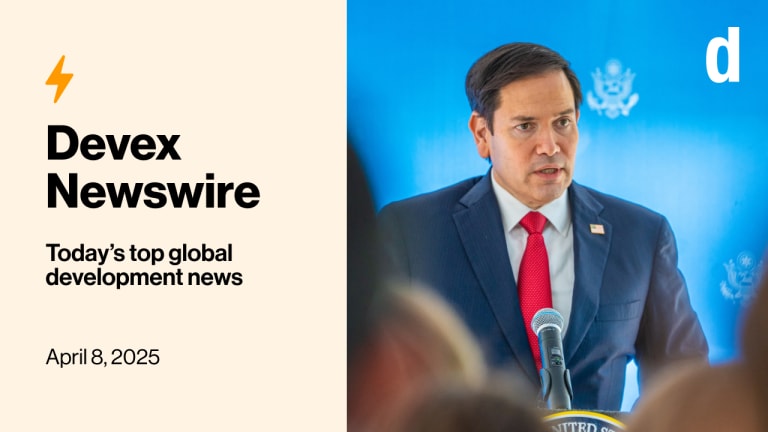Presented by Data.org

Today we’re starting somewhere unusual: Kansas, the American midwestern state where at least 2,000 cows have suddenly dropped dead.
This is a preview of Newswire
Sign up to this newsletter for an inside look at the biggest stories in global development, in your inbox daily.
Scientists and other evidence-based folks have attributed the mass cattle die-off to a heat wave. But the unnervingly large number of people who reside in the conspiratorial corners of social media have identified a different culprit: Bill Gates.
I didn’t go too far down this rabbit hole — and I’m not going to link to the posts — but the “story” they’re pushing seems to be that in the middle of a global food crisis, Gates, one of the largest private owners of American farmland, is wiping out cows due to his own stake in the synthetic meat industry.
This is just the latest concoction of an alternate reality in which Gates is the secret mastermind behind pretty much everything that goes wrong these days.
Conspiracists also blame Gates for the infant formula shortage, and of course, accuse him of injecting people with microchips via the COVID-19 vaccines.
One wonders how Bill still finds time to read.
Gates has acknowledged that the conspiracy theories worry him, and he thinks more should be done to understand why they spread and how they influence peoples’ behavior. He’s also managed to find some humor in the dark absurdity of it all.
I’m writing about this now because it turns out the Gates conspiracy theories are an extreme offshoot of a bigger phenomenon.
My colleague Stephanie Beasley reports that in the United States, public trust in nonprofit organizations and philanthropists is declining, and some experts say that as people have grown more distrustful of these institutions and the people who run them, the reasons they give for feeling that way have also changed.
A few decades ago, when Americans said they didn’t trust nonprofits it was often because they believed those organizations and their leaders were “amateurish.” Today, more people seem to believe that philanthropic funders have ulterior motives and are using their funding to advance their own agendas, says Beth Breeze, director of the Centre for Philanthropy at the University of Kent.
“Rather than being worried about good intentions that are imperfectly executed, I think that now the public are worried about the bad intentions of nonprofits and, in particular, of their donors,” Breeze says.
According to research from Independent Sector, a network of U.S.-based nonprofits and philanthropic groups, the percentage of Americans who trust nonprofits fell to 56% — down 3 percentage points since 2020.
Part of the explanation is that public trust in institutions, including government, is declining across the board. And to be clear, there are plenty of legitimate reasons to question the role that philanthropists such as Gates occupy. For example: Is it healthy that the Bill & Melinda Gates Foundation is one of the largest donors to WHO?
But in many cases — another example is Islamic Relief, which has found itself painted with disinformation about alleged support for terrorism — it is the development funders and organizations that have found themselves caught in the crosshairs of political agendas outside their control.
“This all matters a lot, and it matters for donors — individual donors as well as foundation donors,” says Phil Buchanan, president of the Center for Effective Philanthropy.
+ Next month I’ll be hosting a conversation at Devex World in Washington, D.C. on fighting misinformation and disinformation in development. To help me prepare, reply to newswire@devex.com and let me know if your organization has faced social media conspiracies, political attacks, or a loss of public trust — and what you did about it.
Read more: Why are foundations and nonprofits losing public trust?
ICYMI: How Islamic Relief has dealt with disinformation
Tech support
If you’re struggling to find enough money to spend on technology, or unsure which information technology solutions are even available to match your organization’s needs, you are not alone.
From ensuring digital security to finding solutions that work in low-connectivity settings, to supporting local partners, development organizations face a wide range of difficult questions when it comes to building out their IT infrastructure, Rebecca Root reports for Devex
Read: How to choose the right IT for your development organization (Pro)
Devex Pro subscribers can also watch the recording of our Pro Live event on how global development organizations can effectively engage leading tech companies. Not gone Pro yet? Sign up and start your 15-day free trial.
+Tell us: Is there an SDG talent gap — where the skills needed to achieve the SDGs aren’t reflected in the development workforce? Let us know what you think by taking our brief survey about international development recruitment and the Sustainable Development Goals.
Not so Ensemble
France won plaudits for its new development law last year, under which it must “strive to reach” spending of 0.7% of gross national income on official development assistance by 2025. But how much it spends before 2025 is still subject to a vote in the National Assembly — a body that looks very different after Sunday’s legislative election.
President Emmanuel Macron’s Ensemble coalition lost its majority, which would have allowed it to continue governing virtually unimpeded. Meanwhile, the far-right Rassemblement National skyrocketed from eight to 89 seats. So what does that mean for development?
Maé Kurkjian, senior policy and advocacy manager at ONE France, told Devex Monday that this election could change everything when it comes to French development policy. “Long story short: all the progress made in the law will have to [be] approved again by the new [members of Parliament] to ensure it gets proper buy-in.”
She noted that the current law “needs to be completed with the financial trajectory for the core ODA spending” before the end of 2022, and that the finance committee chair will likely be from a left-wing party, which traditionally supports “ambitious” development spending.
French aid: A primer (Pro)
Church and state
“The Catholic Church has a lot of influence in terms of policy."
— Ritah Anindo, youth coordinator, Reproductive Health Network KenyaKenya averaged about 775 pregnancies per day among girls aged 10 to 19 in January and February 2022, according to the country’s ministry of health. The government says that reducing adolescent pregnancy is one of its top priorities — but its efforts have not matched its rhetoric, Sara Jerving reports.
Read: Is religious influence fueling the teen pregnancy crisis in Kenya?
+ Sign up to Faith and Development, our free monthly newsletter that focuses on the role faith groups and their communities play in strengthening global development outcomes.
In other news
Witnesses in Ethiopia said Sunday that more than 200 ethnic Amhara have been killed in an attack in the country’s Oromia region and are blaming a rebel group, which denies it. [The Guardian]
At least 59 people are known to have died in lightning strikes and landslides triggered by severe monsoon storms in India and Bangladesh. Millions of people have been stranded while emergency workers have struggled to reach those affected. [BBC]
Greek authorities said Sunday they have rescued 108 migrants from a sailboat that was found rudderless and leaking water in the Aegean Sea in near gale force winds. [AP News]
Sign up to Newswire for an inside look at the biggest stories in global development.




